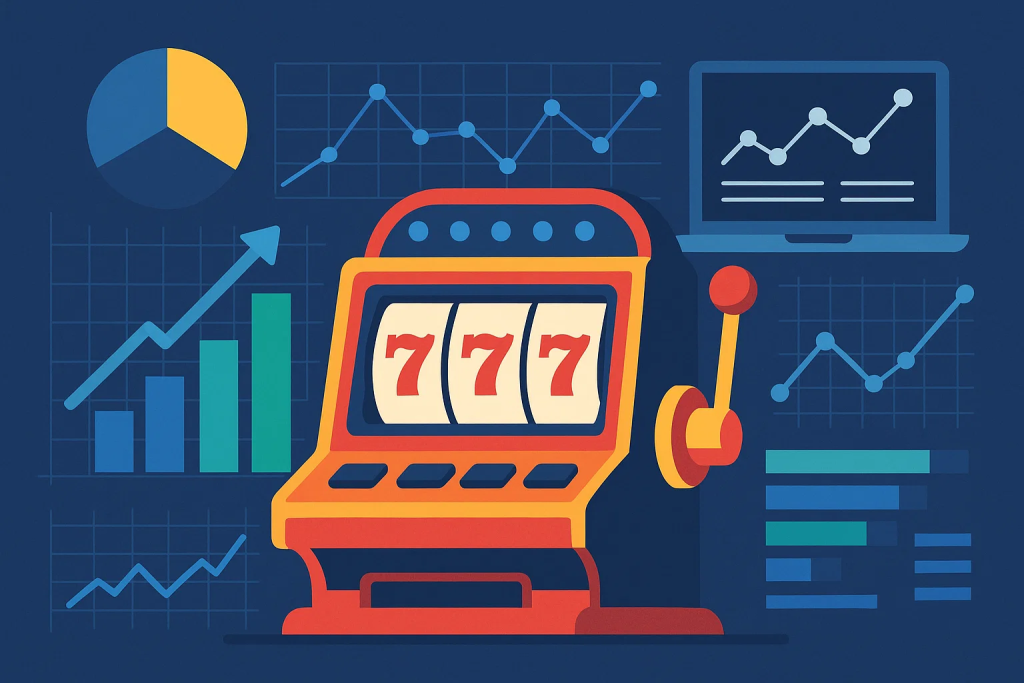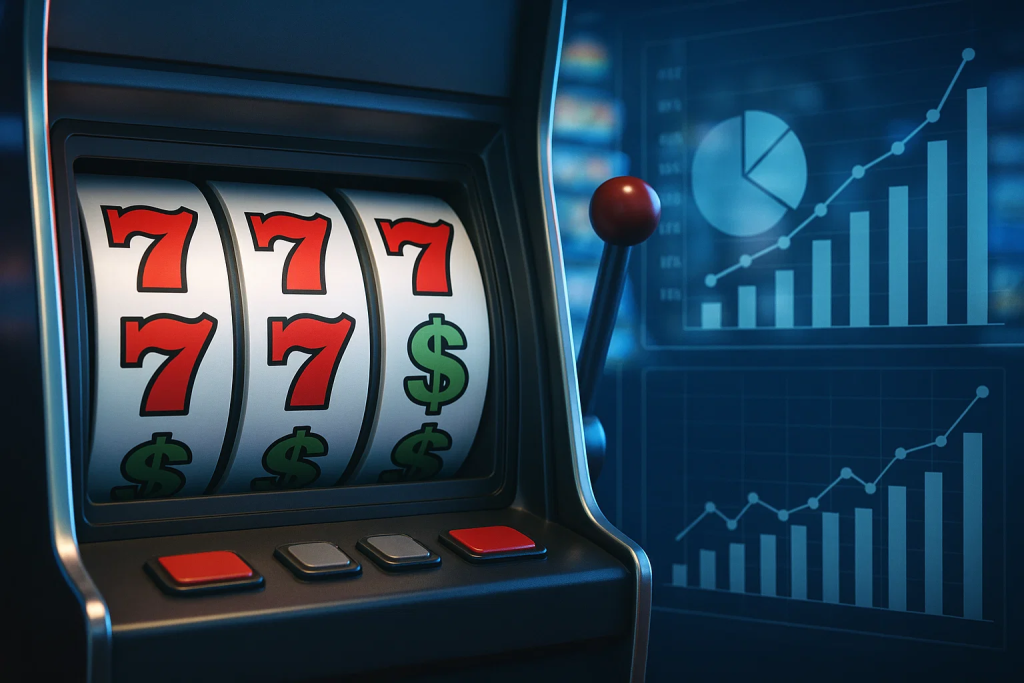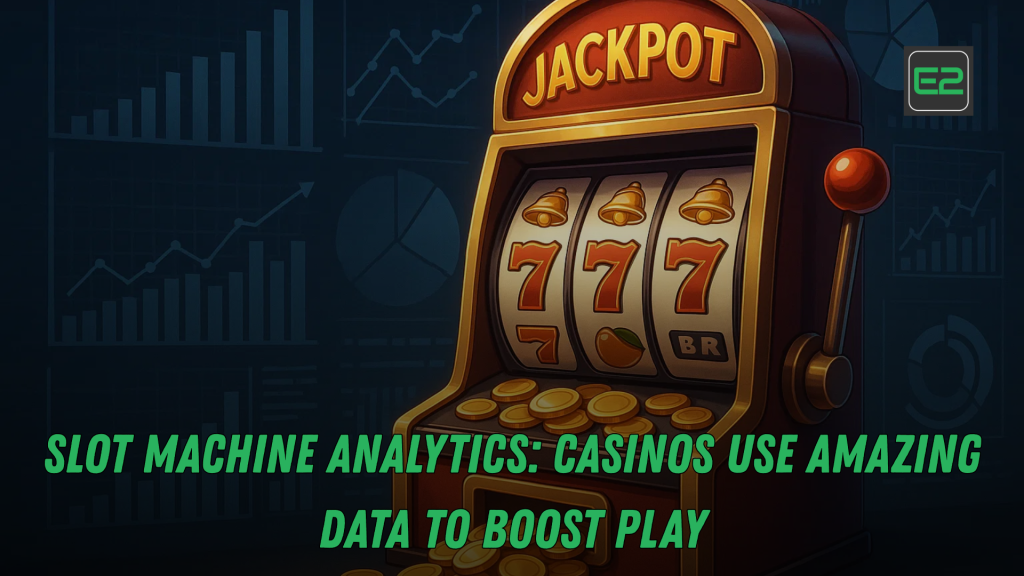Table of Contents
TL;DR (Executive Summary)
Slot machine analytics is the discipline of using data—from meters, player cards, cashless wallets, and floor telemetry—to optimize game mix, pricing (hold%), placement, marketing offers, and maintenance. Done right, analytics increases time-on-device, guest satisfaction, and net win while protecting players through responsible-gaming (RG) guardrails and privacy. This playbook explains the KPIs, data stack, models, experiments, and 12-month roadmap that leading teams use to grow slot revenue ethically and predictably.

Why Slot Analytics Matters Now
- Tighter competition. Integrated resorts and online channels raise guest expectations for immersive, seamless play.
- Rising costs. Capex for cabinets and licensing makes bad game choices expensive.
- Data abundance. TITO, player tracking, cashless, and service systems create minute-by-minute signals you can convert into decisions.
- Regulatory spotlight. As marketing becomes more personalized, RG and privacy move center stage.
Winning teams don’t guess—they measure, test, and iterate.
What Slot Machine Analytics Actually Is
Definition: The structured use of accounting meters, player-behavior data, and floor telemetry to forecast demand, allocate capital, set holds/denoms, arrange floors, target offers, and reduce downtime—all within regulatory limits and RG standards.
Who uses it?
- Slot Operations: Game selection, conversions, banking, placement, floor layout
- Marketing & Loyalty: Segmentation, reinvestment, bonusing, reactivation
- Finance: Forecasts, pro formas, lease vs. buy, ROI on conversions
- IT/Data: Data integration, quality, dashboards, model ops
- Compliance & RG: Privacy, AML, markers of harm, offer governance
- Facilities/Tech: Dispatch, MTBF, predictive maintenance
Core KPIs: The Language of Slot Performance
Accounting & Performance
- Coin-In (Handle): Total wagered amount.
- Win (Drop − Payouts): Cash win from the device.
- Theo Win (Theoretical Win): Expected house win given hold% and coin-in.
- Theo Win = Coin-In × Hold% (for fixed-hold games)
- Hold% / PAR% (Payback inverse): House advantage embedded in the math model.
- RTP (Return to Player): Long-run player payback (RTP = 1 − Hold%).
- Net Win / Net Revenue: Win minus free play and participation fees.
- Time-on-Device (TOD): Active minutes per session/day—proxy for engagement.
- Hit Frequency: % of spins with any win—perceived volatility driver.
- Volatility Index (σ): Variance of outcomes; shapes the “ride.”
Utilization & Yield
- Occupancy: % of time a seat is in play.
- Win per Unit per Day (WUD/WPU): Bread-and-butter unit productivity measure.
- Yield per Square Foot: For space-constrained floors.
- Bet Depth: Average bet relative to denom/min bet—pricing power signal.
Loyalty & Offers
- Carded %: Share of coin-in tracked to players (data quality lever).
- Reinvestment %: (Comps + Free Play) / Theo Win—marketing spend discipline.
- RFM/CLV: Recency, Frequency, Monetary; Customer Lifetime Value.
Reliability & Service
- Downtime / MTTR / MTBF: Mean time to repair/fail—hard revenue protectors.
- Dispatch SLA: Time-to-seat after fault.
Data Sources and Architecture (Keep It Practical)
- Slot Accounting System: Meters, events, themes, denoms, PAR sheets.
- Player Tracking & Loyalty: Sessions, offers, redemptions, tier movement.
- Ticketing (TITO) & Cashless: Wallet loads/unloads, tokenized payment trails.
- Service/Dispatch: Fault codes, service durations, part usage.
- Floor Telemetry: Polling events (door open, hopper empty), session starts/stops.
- External: Weather/events, payday calendars, flights, hotel occupancy, digital ads.
Data Flow:
- Ingest: Batch (nightly) for financials; near real-time for ops and service.
- Validate: Meter integrity checks, denom/theme mapping, time alignment.
- Model: Forecasts (ARIMA/Prophet), attribution (MMM), optimization (LP/MIP), propensity (GBM/Tree).
- Activate: Dashboards, floor heatmaps, offer engines, tech dispatch, A/B systems.
- Govern: Role-based access, PII tokenization, RG controls, audit trails.
The Five Levers of Slot Analytics
1) Game Mix Optimization
Goal: Choose which themes, cabinets, and math models to place (and retire).
- Lifecycle curves: Launch, honeymoon, plateau, decay—know normal vs underperform.
- Peer cohorts: Compare like-for-like (cabinet class, denom, math family).
- Top-decile protection: Bank winners; extend with progressives or side games.
- Bottom-quartile actions: Convert, relocate, or retire after A/B testing changes.
- ROI logic: Favor titles that lift WPU and TOD without overspending comps.
Pro tip: Don’t confuse novelty spikes with sustainable demand. Watch 4–6 week rolling trends versus a peer cohort.
2) Pricing & Denomination Strategy (within regs)
Goal: Align hold%, denoms, and min-bet ladders to guest expectations and floor economics.
- Denom migration: Many floors see higher WPU on well-executed denom ladders that lift bet depth without shocking value perception.
- Hold discipline: Resist reflexive hold increases; high-hold may boost short-term win but can erode TOD, carded%, and long-run loyalty.
- Volatility fit: Pair high-volatility titles with progressives and jackpot zones; keep low-volatility titles near casual traffic.
- Regional norms: Align to local expectations (tourist vs local markets).
Guardrail: Always check regulatory payback rules and disclosures before parameter changes.
3) Floor Layout & Placement
Goal: Use pathing heatmaps and bank logic to increase discovery and comfort.
- Anchor zones: Entrances, high-traffic corridors, pillars with sightlines.
- Bank composition: Mix of hero titles, workhorses, and progressives per bank.
- Adjacency: Place similar math families together; avoid sound/visual clashes.
- Seating comfort: Elbow room, lighting, airflow; ADA routes matter to TOD.
- Wayfinding & signage: Themed micro-districts (“Jackpot Alley,” “Classic Reels”).
- Experiments: Rotate banks quarterly; test micro-moves 6–12 feet—track WPU deltas.
Pro tip: Map “dead ends”—if people rarely pass a zone, even great games underperform.
4) Bonusing, Free Play, and Reinvestment
Goal: Spend marketing where it changes behavior—not where it pays for behavior that would have happened anyway.
- Propensity-to-visit models: Predict lift from offers; suppress for low-ROI segments.
- Reinvestment tiers: Guardrails by Theo and CLV, not just recent spend.
- Real-time triggers: Birthday on-property, jackpot near-miss clusters, long sessions—send non-monetary perks first (host visit, drink, seat move).
- Offer hygiene: Cap free-play burn rates, require earn-ups, avoid all-or-nothing promos.
- Attribution: Tie uplift to incremental coin-in by segment and time window.
Pro tip: Free play is powerful—but comp bloat is real. Publish a reinvestment policy and hold to it.

5) Uptime, Reliability, and Service
Goal: Minimize downtime that destroys WPU.
- Predictive maintenance: Flag devices with rising fault frequency (bill acceptors, printers, doors).
- Smart dispatch: Route nearest tech with right parts; track MTTR improvements.
- Tech KPIs: First-time fix rate, parts-to-failure ratios, ghost faults.
- Guest save: If a game fails during a hot session, host intercept with seat transfer and courtesy comp.
Pro tip: One hour of downtime on a top-10% unit can erase days of optimization gains.
Modeling Toolkit (Plain English)
- Forecasting (Demand): ARIMA/Prophet/ETS to predict WPU by unit/bank/day.
- Choice Modeling: Understand which attributes (theme, denom, cabinet, location) drive seat choice.
- Optimization (Floor & Capital): Linear/mixed-integer programming to assign limited slots and capex for maximal WPU subject to spacing and electrical constraints.
- Propensity (Offers): Gradient-boosted trees to estimate visit or coin-in lift from each offer type.
- Uptime Risk: Survival analysis for time-to-failure on components.
A/B Testing for Slots (Yes, It’s Possible)
- Placement test: Move bank 12 feet; split-run weeks (A weeks vs B weeks).
- Denom ladder test: Introduce 1¢/2¢/5¢ mix on half the bank; compare WPU, bet depth.
- Signage test: Themed signage vs generic; measure click-through to seats (via observation or proximity counters).
- Offer test: 20% lower free-play for mid-tier segment; see if visit frequency holds.
Rules: One change at a time per zone; run long enough to wash out day-of-week effects; pre-register success criteria.
Responsible Gaming (RG) & Ethics—Non-Negotiables
Analytics should increase satisfaction and reduce harm:
- Markers of harm: Unusual session frequency, chasing behavior (within what can be lawfully detected), repeated declines—route to welfare checks.
- Offer controls: Suppress monetary offers to at-risk profiles; prefer non-gaming experiences (dining, show).
- Self-exclusion & cool-offs: Make them easy to initiate and honor across channels.
- Ad standards: No glamorizing “get rich quick,” no minor-targeted creative.
- Privacy: Tokenize PII; store minimal data; audit access; align with local data-protection law.
- Fair play: Analytics does not alter game outcomes—math is certified. Focus on experience, not manipulation.
Trust keeps guests returning. Lose it—and no model can fix that.
Cashless, Omnichannel, and the New Guest Journey
- Cashless wallets: Lower friction at the seat; improve session continuity (more TOD).
- On-property apps: Wayfinding to favorite games, queue for popular banks, order F&B to seat.
- Omnichannel: If legal, link online and retail loyalty so offer timing and value feel seamless.
- Consent management: Clear toggles for data use; explain benefits (faster service, tailored experiences).
Dashboards That Teams Actually Use
Executive: WPU trend, top/bottom 10% units, bank heatmap, reinvestment %, RG summary.
Slot Ops: WPU by unit/bank, occupancy, TOD, denom mix, conversion watchlist.
Marketing: Carded %, RFM ladder, reinvestment by segment, offer ROI, churn/reactivation funnel.
Tech/Facilities: Fault rate heatmap, MTTR, predicted failures, parts stockouts.
Compliance/RG: Self-exclusions, flagged sessions (if permitted), offer suppressions, audit logs.
Golden rule: One page per audience; green/amber/red; two actions at the bottom.
90-Day Quick Wins
Days 1–30
- Clean denom/theme mappings; publish top/bottom units.
- Create reinvestment policy by tier & CLV (stop overcomping).
- Launch dispatch SLA (text alerts, nearest-tech routing).
Days 31–60
- A/B denom ladder on one bank.
- Rebank a top-10% title to an anchor zone; measure WPU.
- Start propensity-to-visit pilot for one mid-tier segment.
Days 61–90
- Floor micro-move trial (two banks 6–12 feet).
- Predictive maintenance model v1.
- RG offer suppression rules live; publish KPI to exec.
12-Month Roadmap (Quarter by Quarter)
Q1—Foundations
- Data dictionary, KPI standards, role-based dashboards.
- House reinvestment rules; RG & privacy governance documented.
- Baseline WPU, carded %, TOD, DRB% (device reliability baseline).
Q2—Experiments & Mix
- Two A/B tests (denom ladder, signage).
- Game lifecycle monitoring; retire 10% weakest titles; convert or relocate.
- Propensity offers to two segments; measure incremental coin-in.
Q3—Optimization & Uptime
- Floor optimization model for 20% of the footprint.
- Predictive maintenance v2; MTTR cut by 20%.
- Launch cashless or improve adoption; track session continuity.
Q4—Scale & Culture
- Expand optimized layout to 60% of floor.
- Reinvestment ROI report; reinvest in non-gaming perks where it pays.
- Annual RG & privacy audit; publish guest-facing trust summary.
Success KPIs (illustrative):
- +6–10% WPU on optimized banks; -15–25% downtime on top units; +8–12% carded%; stable reinvestment% with higher ROI; maintained or improved RG markers.
Myths vs Realities
- Myth: “Higher hold always means more revenue.”
Reality: Excess hold can depress TOD and loyalty; optimize, don’t maximize. - Myth: “Analytics manipulates outcomes.”
Reality: Certified math governs outcomes. Analytics tunes mix, placement, pricing within rules, and service. - Myth: “Free play is free money.”
Reality: Poorly targeted free play cannibalizes profit. Use propensity & ROI. - Myth: “We need expensive tracking to start.”
Reality: You can do a lot with clean meters, carded %, and disciplined testing.
Sample Analyses You Can Run This Week
- Cohort Study: Compare WPU for a new title vs three matched peers over 6 weeks; retire/convert if under 70th percentile.
- Heatmap Walk: Chart foot traffic (manual counts or beacons) by hour; reposition a strong title from a cold zone.
- Offer Lift: Randomly hold back 10% of a segment; measure incremental coin-in of those who received vs control.
- Fault Pareto: Top 5 fault codes by downtime; fix the 2 that cost most WPU.
- Reinvestment Sanity: For each tier, sort by reinvestment ROI; trim the bottom quartile.

Strong Call-to-Action
Operators & Owners: Ready to turn your slot data into predictable growth—without breaking guest trust?
- Start with our 90-Day Quick Wins and commit to two A/B tests this quarter.
- Publish a reinvestment policy and RG guardrails your whole team can recite.
- Build one-page dashboards by role; end each with two actions.
Want a free, customizable Slot Analytics Starter Kit (KPI dictionary, WPU dashboard template, reinvestment policy worksheet, A/B test planner, and RG governance checklist)?
Comment “SEND SLOT KIT” with your role (ops/marketing/finance/tech) and we’ll share the files you can deploy this week.
Frequently Asked Questions (FAQ)
1) Does using slot analytics change game outcomes or fairness?
No. Analytics does not change the certified math or outcomes of any game. It helps decide which games to place, where to place them, how to set legal denoms/holds, and how to maintain/market them. Fairness remains governed by certified RNGs, pay tables, and regulation.
2) What’s the difference between RTP, hold%, and theo win?
RTP is the long-run share returned to players; hold% is the house advantage (Hold% = 1 − RTP). Theo win is the house’s expected win given coin-in and hold (Theo = Coin-In × Hold%). Finance and marketing use theo to set reinvestment and comps.
3) How much free play should we reinvest?
There’s no universal number. Create guardrails by tier and CLV, and measure incremental lift. Healthy programs often shift spend toward segments and moments where offers change behavior (visits, time, coin-in) and away from segments where free play is mostly giveaway.
4) Can we A/B test slot decisions like in e-commerce?
Yes—with care. Test one variable per zone (placement, denom ladder, signage, offer) and run long enough to overcome day-of-week and event noise. Pre-register your success metric (e.g., WPU +5%) and keep a control.
5) How do we grow carded play without being intrusive?
Make the card or app useful: faster service, personalized wayfinding, cashless convenience, and non-gaming perks (dining, shows). Be transparent about data use, allow easy opt-outs, and ensure RG and privacy are visible in your guest communications.
Final Word
Slot analytics isn’t about squeezing players—it’s about engineering better experiences: the right game in the right place, priced and maintained well, with smart offers, fast service, and safeguards that protect people. When you align math, models, and morals, you get more than revenue: you earn repeat visits, positive word of mouth, and a durable brand in a competitive market.
Slot machine analytics uses data from accounting meters, player cards, cashless wallets, and floor telemetry to optimize a casino’s game mix, pricing (hold%/denoms), placement, marketing offers, and machine uptime—while enforcing responsible-gaming (RG) and privacy. Core KPIs include coin-in, theoretical win, hold%/RTP, time-on-device, hit frequency, volatility, occupancy, win per unit per day (WPU), carded play %, reinvestment %, downtime/MTTR, and MTBF. A practical data stack ingests and validates slot/accounting, loyalty, TITO/cashless, service/dispatch, and external signals (events, hotel occupancy), then activates insights via dashboards, offer engines, floor heatmaps, and predictive maintenance under strict governance.
Five revenue levers drive results: (1) Game mix (lifecycle monitoring, cohort comps, convert/retire laggards), (2) Pricing/denoms (bet-depth without eroding value), (3) Floor layout (pathing, bank logic, signage), (4) Bonusing/reinvestment (propensity-driven, CLV-based guardrails), and (5) Uptime (predict failures, smart dispatch, guest save). Modeling tools span forecasting, choice modeling, linear optimization, propensity scoring, and survival analysis. Teams A/B test bank placement, denom ladders, signage, and offer design.
RG is non-negotiable: markers of harm, self-exclusion, offer suppression, transparent privacy. Cashless and omnichannel improve continuity and convenience. The playbook ends with 90-day wins, a 12-month roadmap, role-specific dashboards, and myth-busting (e.g., “higher hold ≠ always more revenue”), showing how ethical analytics grows WPU, loyalty, and long-term brand trust.
